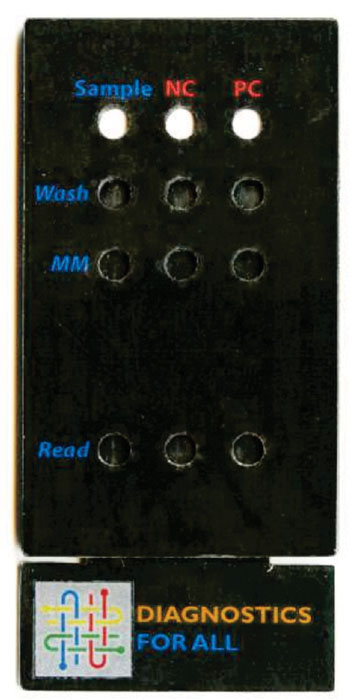Portable Paper Machine Can Diagnose Disease Cheaply
By LabMedica International staff writers
Posted on 05 Aug 2015
The unparalleled sensitivity and specificity of nucleic acid amplification tests (NAATs), led by those based on polymerase chain reaction (PCR), have become increasingly available in the developed world for the diagnosis of infectious, genetic, and other diseases.Posted on 05 Aug 2015
In countries where resources are limited, performing the same diagnostics is far more challenging, so a portable, low-cost “paper machine” for point-of-care detection of infectious diseases, genetic conditions and cancer has been developed to address this problem.

Image: The portable, low-cost paper machine for point-of-care detection of infectious diseases, genetic conditions and cancer (Photo courtesy of Diagnostics for All).
Scientists at Diagnostics For All (Cambridge, MA, USA) collaborating with Harvard University (Cambridge, MA; USA) developed a device that integrates sample preparation and loop-mediated isothermal amplification (LAMP) with end point detection using a hand-held UV source and camera phone. The prototype device integrates paper microfluidics and a multilayer structure, or a “paper machine” that allows a central patterned paper strip to slide in and out of fluidic path and thus allows introduction of sample, wash buffers, amplification master mix, and detection reagents with minimal pipetting, in a hand-held, disposable device intended for point-of-care use in resource-limited environments.
The device creates a dynamic seal that prevents evaporation during incubation at 65 °C for one hour. This interval is sufficient to allow a LAMP reaction for the Escherichia coli maltoporin (malB) gene to proceed with an analytical sensitivity of one double-stranded DNA target copy. Starting with human plasma spiked with whole, live E. coli cells, the team demonstrated full integration of sample preparation with LAMP amplification and end point detection with a limit of detection of five cells. Further, it shows that the method used to prepare sample enables concentration of DNA from sample volumes commonly available from fingerstick blood draw.
The authors noted that using materials that cost a less than USD 2 total, they condensed sample preparation, DNA analysis and detection steps into a hand-held paper machine. It successfully determined whether as few as five cells of E. coli were present in test samples. The results can be read using ultraviolet light and a smartphone camera. The investigators said they are further refining the machine to make it even simpler to use. The study was published on June 23, 2015, in the journal Analytical Chemistry.
Related Links:
Diagnostics for All
Harvard University













